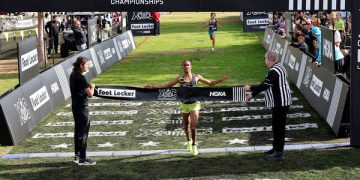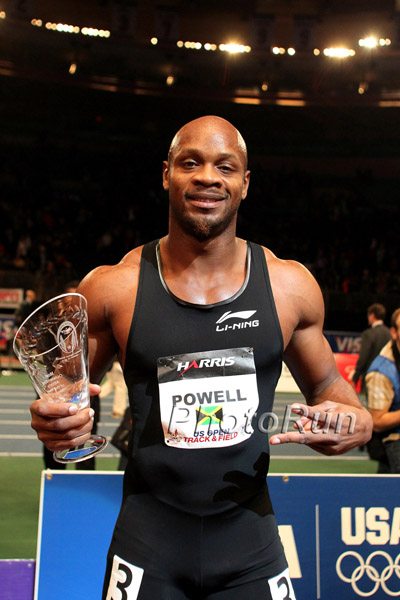
Updated Monday, January 30, 2012
The event was done, in a few months. If they promote early, they could double the crowd. But, USATF and other sponsors need to be a bit more creative on tickets. Read our opinion piece, re-edited, later today, on how to accomplish that. The US Open was a very good way to open the elite indoor season. Now, on to the New Balance Indoor Grand Prix.
US OPEN 2012
By ELLIOTT DENMAN
 Fawn Dorr, 2012 US Open, MSG stylin, photo by PhotoRun.net
Fawn Dorr, 2012 US Open, MSG stylin, photo by PhotoRun.net
NEW YORK – Strictly speaking, this isn’t a “new” Madison Square Garden.
The “really new” Madison Square Garden was scheduled to rise a block
away from the current edition, west across Eighth Avenue to the site of
the massive James Farley Post Office.
But then, amid the intrigue of The Big Apple’s failed bid to host
the 2012 Olympic Games, and the concept of the giant West Side Stadium,
which never happened, the politicans and the real estate moguls locked
horns and the project was eventually skewered.
So MSG and Cablevision chieftain James L. Dolan settled for major
renovations of the existing structure, complete with tons of marble
flooring, elegant concourses linking its various areas, and, needless to
say, an array of luxury suites where the corporate crowd would be
spared the inconvenience of rubbing shoulders with the common folks.
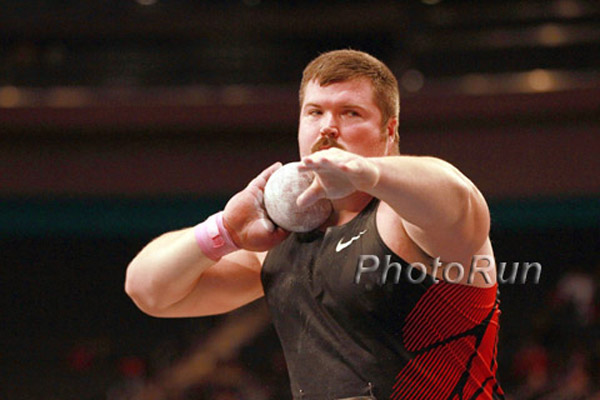 Christian Cantwell, 2012 US Open, photo by PhotoRun.net
Christian Cantwell, 2012 US Open, photo by PhotoRun.net
And some great snacking – for a price, of course.
Pastrami sandwiches go for $14.95, chicken sandwiches $13.95, beer
(imported) $10.00 and domestic ($9.50), chilidogs $6.95, hotdogs (large)
$6.25 and (small) $5.75, crackerjacks $5.75, french fries $4.95, iced
tea $5.25, bottled water $5.00, coke and lemonade $4.75.
So where did track and field, a staple of Madison Square
Garden-going through the eras of all four Garden edifices (which rose in
1879, 1890, 1925 and 1968) – fit into this bigger, big-bucks picture?
For a stretch – after the Millrose Games headed for the exits and
moved 135 blocks northward in Manhattan, 33rd Street to 168th Street, to
The Armory Track and Field Center – it seemed that
there’d be no track and field in the Garden’s future at all.
And that’s where USA Track and Field, working closely with the Garden
itself and major sponsors, stepped in. That’s where they decreed that
there’d be track and field at the building after all. And that’s when –
on just a few months’ notice – plans were unveiled to create the U.S.
Open.
The date would be the fourth Saturday of January, the U.S. Open to
occupy the evening session of the day that would begin, as it had for 38
years, with the staging of the Colgate Women’s Games.
And so it happened. A “crowd” of 5,844 turned out, attracted by
major USATF advertising (including a giant billboard hovering over Times
Square), and word-of-mouth encouragement within the track community.
With ticket prices beginning at a most-modest 15 bucks. But nearly zero
attention from the NYC media (semi-predictable in a week filled with
every nugget of Giants’ Super Bowl preparation.)
Vast sections of the building often called “the world’s most famous
arena” were closed off. The building (to the opimists) was nearly
one-third full. To the nattering negativists, it was over two thirds
empty.
But at least track and field was there, the message on all those
“track is back” t-shirts we’ve seen over the years was right, after all.
Dan O’Brien did his best to rev-up the “crowd” for the compact,
17-event slate that lasted just under three hours, 7 to just before 10
p.m., about the same time attention span expected by the Knick and
Ranger faithful.
And Garden-goers did get a quality, although often bare-boned show.
Starting from the end:
Asafa Powell rang down the curtain with his second, 9:55 p.m.
5.64-second 55-meter sprint victory over Nesta Carter (5.67) which again
demonstrated the talents of this man who has recorded more sub-10
100-meter performances than any runner in history.
“I’m fit, but not really fast,” he declared after this first race of his Olympic year season.
He was asked, too, if dash-deep Jamaica (with Usain Bolt and Yohan
Blake, not here) along with Powell and Carter, can actually sweep the
gold, silver and bronze medals in the 100-meter final at the London
Olympic Games.
(This is a feat – don’t you remember? – achieved just twice in
Olympic history, by the American trios of Ralph Craig, Alvah Meyer and
Donald Lippincott in 1912, and Archie Hahn, Nate Cartmell and William
Hogenson in 1904.)
“Yes, it is definitely possible,” said Powell. “Surely (a 1-2-3) can be done. We have some amazing runners.”
But he quickly reminded his interviewers, that in this always
what-have-you-done-for-me lately sport, “nothing’s ever certain.”
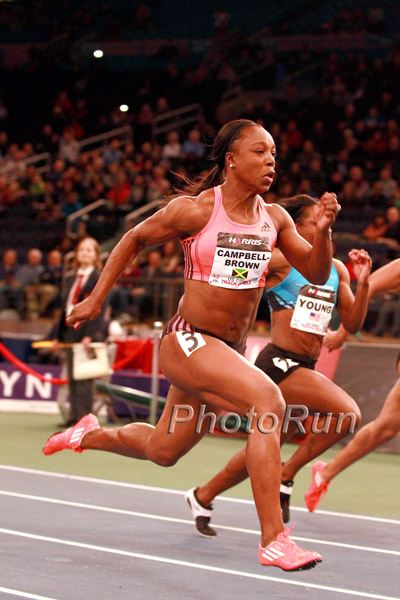 Veronica Campbell-Brown, 2012 US Open, photo by PhotoRun.net
Veronica Campbell-Brown, 2012 US Open, photo by PhotoRun.net
Not even Veronica Campbell-Brown, the leading lady of the Jamaica
women’s sprint corps, who took her own 50 at the Garden in .6.08,
winning easily over USA’s Jessica Young (6.20 ) and Nigeria’s Gloria
Asumnu (6.22.)
No sprinter, male or female, has ever won three straight at the
Olympic Games. Carl Lewis sprinted to men’s 100-meter crowns in 1984 and
’88; Wyomia Tyus won the women’s 100 in 1964-68, and Gail Devers the
same two in 1992-96. But it’s clear that Campbell-Brown, who won the
200 at Athens in 2004, repeated at Beijing in 2008, will be right in the
mix, once more, in London.
Terrence Trammell, who took Olympic silver medals in the 110 high
hurdles in 2000 (Sydney) and 2004 (Athens) isn’t going to fade away,
either. After missing the U.S. team in 2008, he’s clearly back in the
picture, after his 6.45 50 hurdles win over David Oliver.
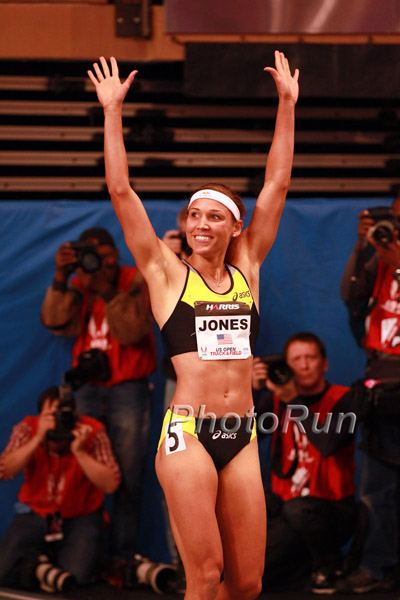 LoLo Jones, 2012 US Open, photo by PhotoRun.net
LoLo Jones, 2012 US Open, photo by PhotoRun.net
And so is Lolo Jones, winner of the women’s 50 hurdles in 6.78..
Here’s a young lady who suffered memorable mental trauma in the Beijing
100 hurdles final (leading over the eighth hurdles, she clipped the
ninth, stumbled over the 10th and wound up a very unhappy seventh place.
But after overcoming the rigors of spinal surgery last summer, Lolo declares herself “definitely back in the picture.”
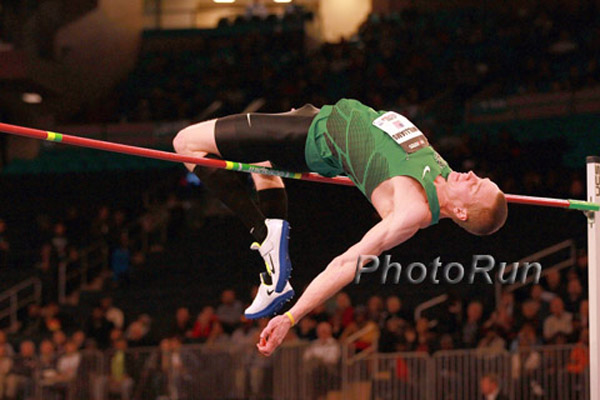 Jesse Williams, 2012 US Open, photo by PhotoRun.net
Jesse Williams, 2012 US Open, photo by PhotoRun.net
There were smiles, too, for men’s HJ winner Jesse Williams – after he
won his season-opener with a solid 7-6 clearance. But frowns for Jenn
Suhr, the number one-ranked women’s PVer, who flunked her three attempts
at opening height and saw the event go at 14-10 to Jillian Schwartz,
the Duke grad who was a member of the 2004 USA Olympic team and now
represents Israel.
Ryan Whiting turned the tables of more-honored American shot put
colleagues, Christian Cantwell and Adam Nelson, with a 69-5 1/4 heave.
The men’s mile – forever the centerpiece of past Garden meets – was semi-disappointing.
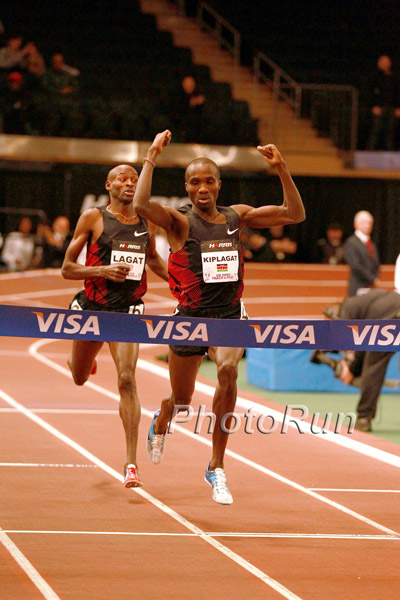 Silas Kiplagat, Bernard Lagat, 2012 US Open, photo by PhotoRun.net
Silas Kiplagat, Bernard Lagat, 2012 US Open, photo by PhotoRun.net
Sure three greats – USA’s Bernard Lagat, and Kenya’s Silas Kiplagat
and Daniel Komen – were there but some modest early pacework (60ish
laps) combined with no blazing final-lap spurting produced a winning
time that (ho hum) was over four minutes. We are well into the 21st
century – winning miles of 4:00.65 do not satisfy the cash customers.
Lagat, however, did have the bext of explanations. He’s really in
super shape. He’s really ready to bust one. And that will be in the
5,000 meters at the Millrose Games at the Armory on Feb. 11th.
So, on to the bottom line question:
Does the U.S. Open have a future?
Answer: It’s a definite maybe..
Despite its 145-meter track, the Garden and all its amenities, which
come at a price, may yet again prove itself a track and field mecca.
With a little more advance notice, and continuing support of USATF and
the Garden’s top brass, and corporate partners, future editions the U.S.
Open may indeed “catch on” and build a tradition of their own.
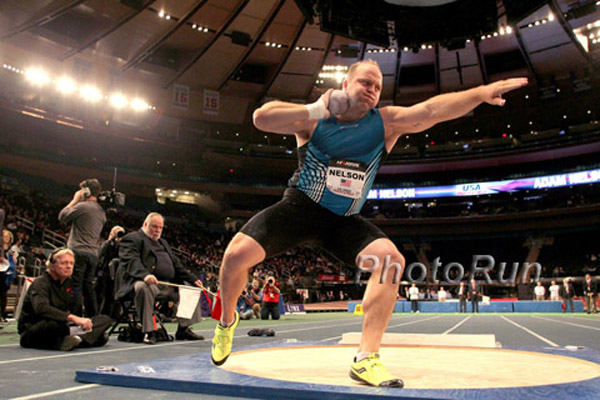 Adam Nelson, 2012 US Open, photo by PhotoRun.net
Adam Nelson, 2012 US Open, photo by PhotoRun.netAuthor

Larry Eder has had a 52-year involvement in the sport of athletics. Larry has experienced the sport as an athlete, coach, magazine publisher, and now, journalist and blogger. His first article, on Don Bowden, America's first sub-4 minute miler, was published in RW in 1983. Larry has published several magazines on athletics, from American Athletics to the U.S. version of Spikes magazine. He currently manages the content and marketing development of the RunningNetwork, The Shoe Addicts, and RunBlogRun. Of RunBlogRun, his daily pilgrimage with the sport, Larry says: "I have to admit, I love traveling to far away meets, writing about the sport I love, and the athletes I respect, for my readers at runblogrun.com, the most of anything I have ever done, except, maybe running itself." Also does some updates for BBC Sports at key events, which he truly enjoys. Theme song: Greg Allman, " I'm no Angel."
View all posts




